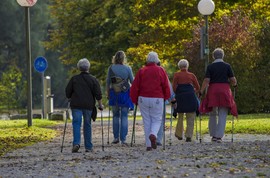With how busy life can be, many of us may not be getting enough physical activity, which increases the risk of a multitude of chronic diseases including diabetes mellitus, high blood pressure, obesity, and heart disease.
The good news is that brisk walking is a simple activity that is not only safe, but is also an effective activity that can counteract the effects of leading a sedentary lifestyle.
 Nordic pole walking began in Finland in 1997 and involves walking with the assistance of poles, which provides the advantage of actively engaging the upper body and upper extremities.
Nordic pole walking began in Finland in 1997 and involves walking with the assistance of poles, which provides the advantage of actively engaging the upper body and upper extremities.
It provides health and wellness benefits to individuals of all fitness levels and can be done almost anywhere, at any time of the year. Individuals with joint problems especially benefit from Nordic pole walking because the poles help to distribute weight evenly, which helps to lessen the load on the joints of the body, including the back, hips, knees, and ankles. Further, older adults that need assistance with balance can also safely participate in this activity as the poles act as a balance measure and encourage a correct gait pattern by naturally aligning the spine and strengthening the core.
Much of the popularity of this activity may be due to the increased energy expenditure compared to conventional walking. Research has shown that conventional walking utilizes less than 50% of the major muscles of the body compared to over 90% with pole walking. Furthermore, pole walking increases your heart and cardiovascular rate by 20% and your calorie burn by 46%, without any additional effort. Research has shown that 30 minutes of Nordic pole walking is equivalent to 50 minutes of conventional walking, so if you’re limited for time, adding Nordic poles to your daily walks can be an easy solution. In addition to the physical benefits of Nordic pole walking, engaging in this activity increases the production of “feel good” hormones, which helps with the management of stress and other mental health conditions.
Nordic pole walking can be easily introduced and maintained as part of your daily exercise routine – all you need is poles and a walking surface. It can be done indoors or outdoors, so weather elements won’t affect your ability to participate in this activity. Make sure you have good walking footwear for the terrain you will be on, and the value of proper stretching after walking can’t be undersold! Cooling down with some steady static stretches for the upper and lower body after pole walking will help prevent post exercise soreness or a repetitive strain injury.
If you want to get started with Nordic pole walking and want to enjoy the activity fully and prevent injury, you may benefit from a consultation with a physical therapist. Undergoing a comprehensive evaluation by a physical therapist at Iron City Physical Therapy is one of the best ways to gain an understanding of how you can enhance your health with Nordic pole walking. After the assessment, our physical therapists will create a program that is specific to your needs, and can help get you started with Nordic pole walking and minimize your risk of injury.
References
1. Tschentscher M, Niederseer D, Niebauer J. Health Benefits of Nordic Walking. American Journal of Preventive Medicine. 2013;44(1):76-84. doi:10.1016/j.amepre.2012.09.043.
2. Camino P, Tsotsos L, Spadafora P, Quinn G, Ballamy G. Impact of an 11-week Nordic Pole Walking Program on the overall Feelings of Health, Wellbeing and Motivation in Older Adults. Centre Publications and Scholarship. 2015; Paper 21
3. Pole Walking Benefits. Nordixxcom. 2017. Available at: https://www.nordixx.com/pages/benefits-of-pole-walking/. Accessed March 14, 2017.
4. Pellegrini B, Peyré-Tartaruga L, Zoppirolli C et al. Exploring Muscle Activation during Nordic Walking: A Comparison between Conventional and Uphill Walking. PLOS ONE. 2015;10(9):e0138906. doi:10.1371/journal.pone.0138906.




